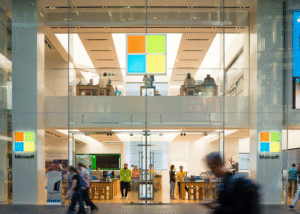On a day when Wall Street was desperately trying to stay in the green, the New York Stock Exchange teemed with bad news. What was the big story? Weak manufacturing numbers raised new worries about a possible recession. The stock market took a nosedive, showing just how jittery investors are about the state of the economy.

Nvidia’s Big Slide
One of the biggest stories was the sharp drop in the stock price of Nvidia. Nvidia is one of the leading companies in the field of artificial intelligence, and its shares plummeted almost 8%. This chopped more than £220 billion off the value of the company. It was a tough blow coming after a recent financial report failed to impress investors despite sales doubling.
Nvidia’s problems dragged the entire sector lower. The index of 30 major US chipmakers fell 6.5%. This was part of a broader market selloff: The Nasdaq Composite, weighted with technology issues, fell 2.4%, while the S&P 500, a benchmark of US stocks, lost 1.4% and the Dow Jones Industrial Average, which tracks 30 large companies, dropped 1%.
Manufacturing Sector Woes
So, why such a sharp fall in the stock market? It looks like the manufacturing sector in the US is a mess. For the fifth month in a row, manufacturing activity has contracted. According to the Institute for Supply Management-ISM-the manufacturing index, known as the PMI, was 47.2 for August. This is slightly better than July’s reading of 46.8, but still below 50, which indicates contraction for the sector.
Tim Fiore of ISM explained that companies were not in a hurry to undertake new projects or inventories. The reason for such steps on the part of corporations, he said, was attributed to the present governmental policy, as well as the result of the forthcoming election. Whenever businesses are reluctant to spend, the pace of growth economic growth may slow down.
The Federal Reserve jacked up interest rates earlier this year to fight hot inflation. Now, the Fed is said to be talking about a rate cut to perk up the economy. That would make it easier and cheaper for borrowers, thus prompting spending. A full percentage point rate cut would be a dramatic move to ward off recession, traders hope.

The chief investment strategist, Sam Stovall, said speculation over what the Fed will do helped drive today’s market decline. Now, investors are betting a weaker economy would force the Fed to be more aggressive in cutting interest rates.
Upcoming Reports and Economic Uncertainty
It declines in stock price comes when traders were adopting the wait-and-see attitude for the key labour market reports later in the week. Due on Friday, it will issue highly awaited jobs number report; it will indicate how many jobs were added in August, as well as a jobless rate. This will be closely watched because such data has the potential to influence the Fed’s decision on interest rates.
This may be a pivotal jobs report, according to the analyst Stephen Innes. A better-than-expected reading with an unemployment rate lower than expected would add to market confidence, while a disappointing report with a higher unemployment rate could feed into growth concerns.
History and Investor Sentiment
Historically, September has been the worst month of the year for the stock market. In fact, since 1928, the S&P 500-a proxy for the largest broad-based US stock market index-has averaged -1.17% return each September. Indeed, this fact instills caution into investor forecasts.
What’s Next?
With these economic concerns, Wall Street is at work-what with pressure in the market. The weak manufacturing data and steep decline of Nvidia were just about it. Now, investors wait to see how future reports set the economic outlook.

For the time being, the hot spotlight of attention is on the Federal Reserve and what it will do next. Will the Fed cut interest rates in order to help the economy, or will it refrain from doing so and run the risk of deeper recession? The next several days will be pretty important in deciding which way the stock market will go-from here on out-and how the general economy is doing.
Meanwhile, it’s a turbulent time for investors and the market as a whole. Continuing to stay tuned for more updates on this developing situation.











